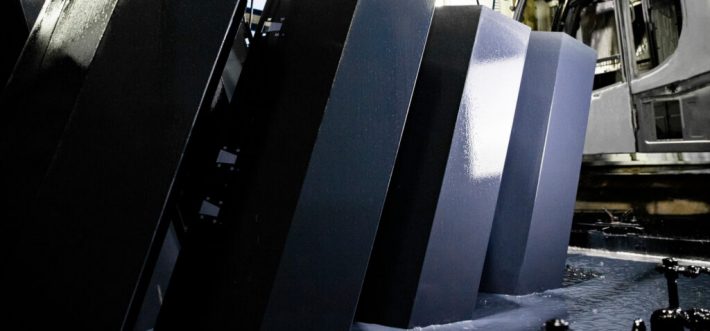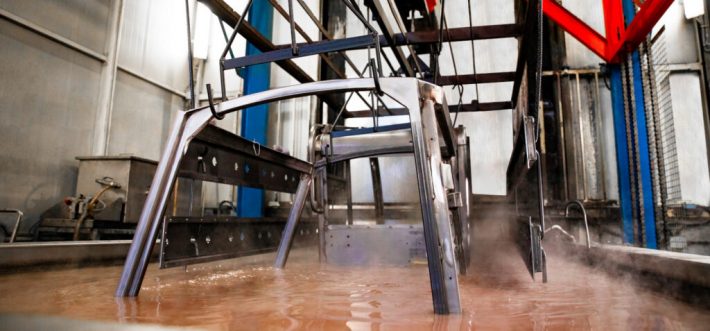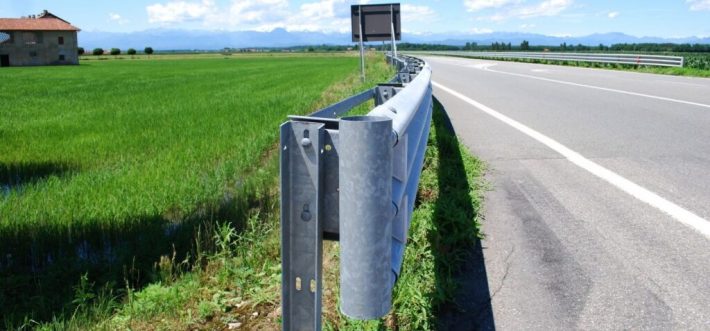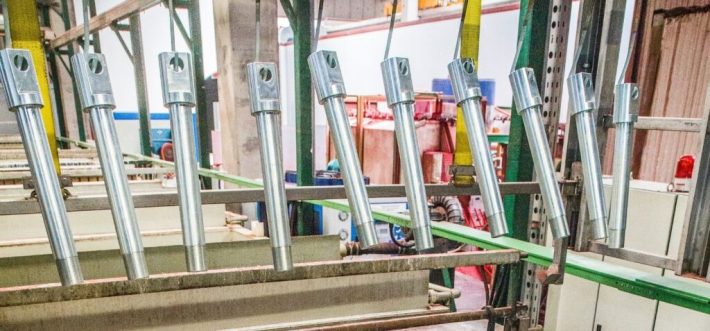E-coating and galvanising are the best treatments for protecting metals from corrosion and external influences. But the question arises: which one should you choose?
Let’s try to clarify a much debated topic: when we think about the protection of metals against external agents, corrosion and oxidation, we often ask ourselves whether it is better to rely on e-coating treatment or galvanizing.
We know well that choosing the right surface treatment is important for the final result of a product and therefore also the protective treatment plays a leading role, as it guarantees the characteristics of an article no less due to the action of time and external agents.
This brief introduction does not clarify the debate: is it better to choose e-coating or galvanizing? Let’s see it together.

E-coating: what it is, how it works and strengths
Let’s start with a basic concept: e-coatingis a treatment that allows you to protect metal items (only metal and metal alloys!) against corrosion and oxidation.
For the process to be successful, it must be made up of several levels, including degreasing phases, which are crucial for high detergency and final cleaning of the products before painting, cleaning and pre-treatment. In these initial phases, alkaline solutions, mains water, phosphating with zinc salts, demi and passivation ensure that the products are prepared for the actual e-coating treatment.
At the end of these “preliminary” steps, the actual e-coating treatment takes place: in a nutshell, it is a process by electrodeposition with which the products, previously connected to the negative pole of an electric generator, are immersed in a large tank where electrodes connected to the positive pole are also immersed. The developing electric field gives rise to electrochemical phenomena that cause the coat to deposit on the product.
Finally, before entering the drying oven, the products are further rinsed with the ultrafiltrate, the liquid part of the bath from which the pigmentation is removed.

As already mentioned, being a cathodic treatment by electrodeposition, it can only be carried out on articles of a metallic nature and, among the positive factors, it should be noted that the e-coating allows a better adhesion of the subsequent finishing coats, if required.
This is one of the reasons why it is a treatment that is closely linked to some of the most demanding product sectors: automotive, agricultural machinery, earth-moving machinery and materials, marine and furniture, to name but a few.
E-coating is a complex process that requires a high level of precision, experience and professionalism, but which is unparalleled in terms of the result: it is no coincidence that it is used for articles that have to operate in extreme conditions and resist for many years before giving way to wear, thus increasing their quality and value..
E-coating: the advantages
- Excellent coverage of edges, corners and openings in articles;
- It is the only process that allows complete coverage of articles, even in the smallest cavities;
- The coating has perfect adhesion and is pore-free;
- Aesthetic perfection of the treated article;
- Very high barrier and protection properties;
- Virtually no solvent use;
- Optimum control of coat thickness;
- Used as an undercoat, it allows excellent adhesion of subsequent finishing varnishes;
- Gives parts high corrosion resistance, up to 700 hours according to ISO 9227;
- Ideal for the most demanding sectors, such as automotive, agricultural and industrial machinery, marine, furniture;
- It is a highly automatable system;
- Ideal for large production runs of uniform items.
E-coating: the disadvantages
- Treatment plants and their maintenance are very complex;
- Large initial capital to start up the plant;
- Little flexibility: generally each tank can only handle one colour.

Galvanizing: a sacrificial treatment against oxidation
From a conceptual point of view, we can think of cataphoresis as a surface coating that places a protective barrier between the article and external agents, while galvanizing is a “sacrificial” treatment. We use this term because, should the substrate come into contact with the external environment (for example, due to a defect or scratch), the substrate would still be protected because the zinc will sacrifice itself for it and will be the first to oxidize. The steps typically involved in galvanizing include an initial degreasing and rinsing treatment, pickling, fluxing with application of a protective film to the surface (useful for preventing oxidation of the item prior to immersion in molten zinc), oven drying and immersion in a tank containing molten zinc. Finally, cooling in air or water takes place.
Galvanizing: the advantages
- Low Costs;
- Easily manageable treatment facilities;
- High resistance against corrosion;
- It is also a well automatable processing.
Galvanizing: the disadvantages
The disadvantages of galvanizing are more related to possible defects of the treated surface, resulting from the processing itself or subsequent storage, including:
- Uneven surface: if the item to be treated has manufacturing defects, galvanizing makes them even more visible, or if the zinc layer is very thick, it can result in roughness, as well as if the treated steel contains high percentages of phosphorus or silicon.
- Hard nodules on the surface: due to the agitation of the slag on the bottom of the tank. The item is still protected from oxidation, but will have an aesthetic problem.
- Presence of white or gray stains: if excessive moisture conditions occur during transport or storage of the treated article, stains caused by zinc oxides and hydrates (white rust) may form. This is a very conspicuous damage, immediately visible to the naked eye, and if the humidity were to be very intense could lead to local destruction of the zinc coating.

Conclusions
Ultimately, each of the two treatments has its own strengths and weaknesses, and in our opinion it is necessary to choose according to the article to be treated.
If the value of the article is not the highest and aesthetic perfection is not fundamental, maybe it is better to opt for galvanizing: it is a valid and functional solution, historically consolidated and with a lower cost, also able to protect metal articles from oxidation and external agents.
Otherwise, if you are looking for a very high quality treatment, especially for items with an important value and that aesthetically must appear perfect, the best choice is cataphoresis. As well as protecting the article with a pre-treatment using zinc salts, it also provides an additional “barrier” with the actual cataphoresis coating, significantly lengthening the life cycle of the treated products.

